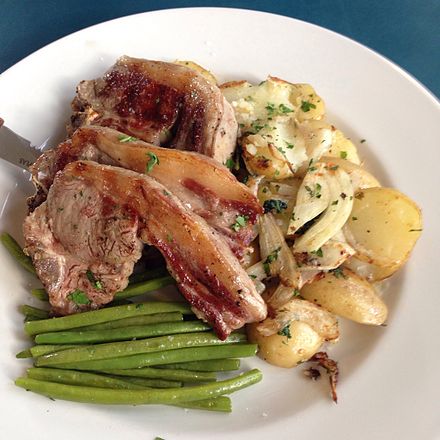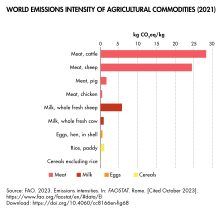.jpg/440px-Lamb_meat_(1).jpg)

Баранина — одно из самых распространенных видов мяса в мире, получаемое от домашних овец Ovis aries и обычно делящееся на ягненка (от овец первого года жизни), хряка (от овец второго года жизни) и баранину (от старых овец). Как правило, «хряк» и «овечье мясо» не используются потребителями за пределами Норвегии, Новой Зеландии, Южной Африки, Шотландии и Австралии. Хряк стал более распространенным в Англии, особенно на севере (Ланкашир и Йоркшир), часто в связи с редкой породой и органическим земледелием.
В южноазиатской и карибской кухне «баранина» часто означает козлятину . [1] [2] [3] [4] [5] В разное время и в разных местах «баранина» или «козья баранина» иногда использовались для обозначения козлятины. [1]
Баранина является самым дорогим из трех видов, и в последние десятилетия овечье мясо все чаще продается только как «ягненок», иногда расширяя принятые различия, приведенные выше. Баранину с более сильным вкусом теперь трудно найти во многих регионах, несмотря на усилия кампании « Возрождение баранины» в Великобритании. В Австралии термин « первосортный ягненок» часто используется для обозначения ягнят, выращиваемых на мясо. [6] Другие языки, такие как французский , испанский и итальянский , делают похожие или даже более подробные различия между овечьим мясом по возрасту, а иногда и по полу и диете — например, lechazo на испанском языке относится к мясу от ягнят, вскормленных молоком (не отнятых от груди).

Определения ягненка, свинины и баранины значительно различаются в разных странах. Молодые ягнята меньше и нежнее. Баранина — это мясо овцы старше двух лет, и у нее менее нежная плоть. В целом, чем темнее цвет, тем старше животное.
В начале 1900-х годов баранина широко потреблялась в Соединенных Штатах, но потребление баранины снизилось после Второй мировой войны . [11] По состоянию на 2010 год [обновлять]большая часть баранины в Соединенных Штатах поступает от животных в возрасте от 12 до 14 месяцев, [12] и называется «ягненок»; термин «кабан» не используется. [13] Федеральные законы и правила, касающиеся маркировки продуктов питания в Соединенных Штатах, разрешают продавать все продукты из баранины как «ягненок». [14] Классы USDA для ягненка лишь частично зависят от возраста животного. Животные в возрасте до 20 месяцев могут соответствовать качеству класса «USDA prime» в зависимости от других факторов, в то время как ягненок «USDA choice» может быть любого возраста. [15] «Весенний ягненок» определяется USDA как забитый в период с марта по октябрь. [16]

В диалекте Романеско потомство овцы, которая еще сосет или недавно отнята от груди, называется abbacchio , в то время как потомство овцы, которой почти год, и которую уже дважды стригли, называется agnello ( буквально « ягненок » ). [17] Это различие существует только в диалекте Романеско. [17] Abbacchio употребляется по всей центральной Италии как пасхальное и рождественское блюдо. [18] [19] [20] Это продукт, защищенный Европейским союзом знаком PGI . [21]
На всей территории центральной Италии , включая Сардинию, основным источником мяса было скотоводство . С древних времен abbacchio был одним из основных продуктов питания региона Лацио , особенно для сельских общин, чье потребление за столом было значительным. [17] Традиция употребления abbacchio распространилась в древние времена, когда в основном забивали взрослых овец . Убой abbacchio был запрещен, за исключением периода Пасхи и Рождества , и до июня. На протяжении столетий, учитывая важность пищи, в Лацио было разработано около 100 рецептов приготовления баранины. [17] Учитывая важность abbacchio в общественной жизни, в регионе Лацио и сегодня организуются исторические мероприятия, посвященные abbacchio , т. е. sagre , сельские фестивали и народные мероприятия. [17] В древние времена овец ели во время работы в сельской местности, в то время как abbacchio употребляли только во время пасхальных праздников. [17]

Термин «баранина» применяется к козлятине в большинстве стран на индийском субконтиненте, и популяция коз растет. Например, баранина карри всегда готовится из козлятины. По оценкам, более трети поголовья коз забивается каждый год и продается как баранина. Популяция домашних овец в Индии и на индийском субконтиненте находится в упадке уже более 40 лет и выживает на маргинальном уровне в горных районах, основываясь на породах диких овец и в основном для производства шерсти . [22]
Мясо ягненка берется от животного в возрасте от одного месяца до одного года, с весом туши от 5,5 до 30 кг (от 12 до 66 фунтов). Это мясо, как правило, более нежное, чем мясо более старых овец, и чаще появляется на столах в некоторых западных странах . Свинья и баранина имеют более сильный вкус, чем ягненок, поскольку содержат более высокую концентрацию жирных кислот, характерных для вида, и некоторые предпочитают их. [27] Баранина и свинина также, как правило, жестче, чем ягненок (из-за созревания соединительной ткани ), и поэтому лучше подходят для приготовления в стиле запеканки , как , например, в ланкаширском рагу .
Баранину часто сортируют на три вида мяса: переднюю четверть, корейку и заднюю четверть. Передняя четверть включает шею, плечо, передние ноги и ребра до лопатки. Задняя четверть включает задние ноги и бедро. Корейка включает ребра между ними.
Бараньи отбивные вырезаются из реберной, поясничной и лопаточной частей. Реберные отбивные включают реберную кость; поясничные отбивные включают только хребтовую кость. Лопаточные отбивные обычно считаются хуже, чем поясничные; оба вида отбивных обычно готовятся на гриле . Грудку ягненка (отбивные из молодой баранины) можно приготовить в духовке.
Нога ягнёнка — целая нога; седло ягнёнка — две поясницы с бедром. Ногу и седло обычно жарят , хотя ногу иногда варят .
Мясо передней четвертины барана, как и других млекопитающих, содержит больше соединительной ткани, чем некоторые другие отрубы , и, если это не молодой ягненок, его лучше всего готовить медленно, используя либо влажный метод, такой как тушение или варка , либо медленное обжаривание или американское барбекю . В некоторых странах его продают уже рубленым или нарезанным кубиками.
Определения бараньей голяшки различаются, но обычно включают в себя:
Баранина барбекю является традицией в Западном Кентукки. Район был развит в торговле шерстью, что давало им много старых овец, которых нужно было использовать. [28]
Из тонкой полоски жирной баранины можно приготовить заменитель бекона, называемый макон .
Язык ягненка популярен в ближневосточной кухне как в качестве мясного ассорти, так и в составе рагу. [29]

Примерные зоны обычных британских кусков баранины: [30]
[32] [33]
Согласно сельскохозяйственному прогнозу ОЭСР - ФАО на 2016 год, крупнейшими потребителями баранины в 2015 году были следующие страны: [34] Страны ЕС не охвачены в этом списке по отдельности. Среди стран ЕС Греция является лидером по потреблению на душу населения с показателем 12,3 кг, [35] в то время как годовое потребление баранины на душу населения в Великобритании составляет 4,7 кг. [36] За пределами ОЭСР крупнейшим потребителем на душу населения в целом является Монголия с показателем 45,1 кг. [36]
В таблице ниже приведена выборка стран-производителей, однако многие другие крупные производители в диапазоне 50–120 кт не указаны.


Мясо барана занимает видное место в кухнях нескольких средиземноморских культур, включая Грецию , Хорватию , Турцию , Северную Африку , Иорданию и Ближний Восток , а также в кухнях Ирана и Афганистана . Например, в Греции оно является неотъемлемым компонентом многих блюд и религиозных праздников, таких как Пасха, как авголемоно и магирица . Оно также популярно в баскской культуре, как в Стране Басков в Европе, так и в пастушьих районах западной части Соединенных Штатов. В Соединенных Штатах навахо включили баранину и ягнятину в свою традиционную кухню с тех пор, как испанские исследователи и поселенцы в 17 веке завезли овец, заменив дикую индейку и оленину и создав скотоводческую культуру. В Северной Европе баранина и ягнятина присутствуют во многих традиционных блюдах, в том числе в Исландии , Норвегии и Западной Европе , включая блюда Соединенного Королевства , особенно в западных и северных возвышенностях , Шотландии и Уэльсе . Баранина раньше была важной частью венгерской кухни из-за сильных скотоводческих традиций, но с распространением урбанизации на нее стали смотреть все более пренебрежительно. [ необходима цитата ]
Баранина также популярна в Австралии . Ягненок и баранина очень популярны в Центральной Азии и в некоторых частях Китая , где другие виды красного мяса могут быть исключены по религиозным или экономическим причинам. Баранина , приготовленная на гриле, также является фирменным блюдом в некоторых районах Соединенных Штатов (в основном в Оуэнсборо, Кентукки ) и Канаде. Однако мясо овец, как правило, потребляется в США гораздо меньше, чем во многих европейских, центральноамериканских и азиатских кухнях; например, среднее потребление баранины на душу населения в Соединенных Штатах составляет всего 400 граммов (14 унций) в год. [36]
В Австралии жареная баранья нога считается национальным блюдом . [38] Обычно подается по воскресеньям или по любому другому особому случаю, может быть приготовлена в котелке для барбекю или в обычной духовке. Типичное приготовление включает покрытие бараньей ноги маслом, втыкание веточек розмарина в надрезы, сделанные на ноге, и посыпание сверху листьями розмарина. Затем баранину запекают в течение двух часов при температуре 180 °C (350 °F) и обычно подают с морковью и картофелем (также жареными), зелеными овощами и подливкой.
В Индонезии баранина обычно подается как сатай из баранины [39] и карри из баранины [40] . Оба блюда готовятся с различными специями с островов и подаются либо с рисом, либо с лонтонгом . Вариант карри из баранины и побегов бамбука является фирменным блюдом кухни Минанг , хотя похожие блюда можно найти и в тайской кухне .
В Мексике баранина является предпочтительным мясом для барбакоа , в котором ягненок жарится или готовится на пару, завернутый в листья агавы под землей. [41]
В Японии , хотя баранина традиционно не употребляется в пищу в большинстве районов страны, на северном острове Хоккайдо и в северо-восточных регионах Тохоку популярно блюдо в горячем горшочке под названием дзингисукан (т. е. «Чингисхан»). В этом блюде тонко нарезанная баранина готовится на выпуклой сковороде вместе с различными овощами и грибами перед посетителями, затем обмакивается в соусы на основе соевого соуса и съедается. Оно было так названо, потому что баранина популярна в Монголии (см. «Употребление баранины» выше).
Печень ягненка , известная как баранья жареная в Новой Зеландии и Австралии, [42] употребляется в пищу во многих странах. Это наиболее распространенная форма субпродуктов, употребляемых в пищу в Великобритании, традиционно используемая в любимом семейном блюде (и основном блюде паба ) печени с луком, возможно также с беконом и картофельным пюре. Это основной ингредиент, наряду с легкими и сердцем (pluck), в традиционном шотландском блюде хаггис .
Бараньи яички или жареный ягненок являются деликатесом во многих частях света.
Бараньи почки встречаются во многих кухнях Европы и Ближнего Востока, часто их разделяют на две половины и жарят на гриле (на шашлыках на Ближнем Востоке) или обжаривают в соусе. Они, как правило, наиболее ценятся из всех почек.
Зобная железа ягненка является деликатесом во многих кухнях. [43]

Производство баранины выделяет больше парниковых газов на грамм белка, чем другие распространенные продукты питания, за исключением говядины. [45]
